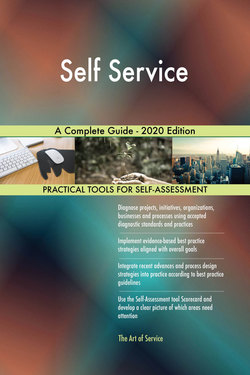Читать книгу Self Service A Complete Guide - 2020 Edition - Gerardus Blokdyk - Страница 10
На сайте Литреса книга снята с продажи.
ОглавлениеCRITERION #4: ANALYZE:
INTENT: Analyze causes, assumptions and hypotheses.
In my belief, the answer to this question is clearly defined:
5 Strongly Agree
4 Agree
3 Neutral
2 Disagree
1 Strongly Disagree
1. What are the sources of data from self-service interactions?
<--- Score
2. What are the best opportunities for value improvement?
<--- Score
3. Do you drive employee experience and engagement through self-service?
<--- Score
4. Do you, as a leader, bounce back quickly from setbacks?
<--- Score
5. Are Self-service changes recognized early enough to be approved through the regular process?
<--- Score
6. How will you manage IT and self-service data integration?
<--- Score
7. Were Pareto charts (or similar) used to portray the ‘heavy hitters’ (or key sources of variation)?
<--- Score
8. Do you have difficulty supporting self-service access to complex data sources?
<--- Score
9. What are the Self-service design outputs?
<--- Score
10. Is the process self-service or managed?
<--- Score
11. What quality tools were used to get through the analyze phase?
<--- Score
12. What are your key Self-service indicators that you will measure, analyze and track?
<--- Score
13. Will your solution be self-serviced locally or provisioned in the data center?
<--- Score
14. What is the cost of poor quality as supported by the team’s analysis?
<--- Score
15. What are evaluation criteria for the output?
<--- Score
16. What conclusions were drawn from the team’s data collection and analysis? How did the team reach these conclusions?
<--- Score
17. Have changes been properly/adequately analyzed for effect?
<--- Score
18. Are users in your organization currently integrating or blending data from sources using a software solutions self-service data preparation capabilities?
<--- Score
19. What process improvements will be needed?
<--- Score
20. Is there any way to speed up the process?
<--- Score
21. What were the crucial ‘moments of truth’ on the process map?
<--- Score
22. Was a cause-and-effect diagram used to explore the different types of causes (or sources of variation)?
<--- Score
23. What are your current levels and trends in key Self-service measures or indicators of product and process performance that are important to and directly serve your customers?
<--- Score
24. Is data and process analysis, root cause analysis and quantifying the gap/opportunity in place?
<--- Score
25. How was the detailed process map generated, verified, and validated?
<--- Score
26. Were any designed experiments used to generate additional insight into the data analysis?
<--- Score
27. Does your self-service product track data point in time?
<--- Score
28. How are outputs preserved and protected?
<--- Score
29. Did any value-added analysis or ‘lean thinking’ take place to identify some of the gaps shown on the ‘as is’ process map?
<--- Score
30. Does your organization systematically track and analyze outcomes related for accountability and quality improvement?
<--- Score
31. Are pertinent alerts monitored, analyzed and distributed to appropriate personnel?
<--- Score
32. What are self-service data discovery and visualisation tools?
<--- Score
33. Are losses documented, analyzed, and remedial processes developed to prevent future losses?
<--- Score
34. Have the types of risks that may impact Self-service been identified and analyzed?
<--- Score
35. Do several people in different organizational units assist with the Self-service process?
<--- Score
36. How can the available data be enriched to allow for self-service?
<--- Score
37. What is a service recovery process from a self-service technology approach?
<--- Score
38. Does the knowledge management module include the ability to establish expiration dates that drive update alerts to the document owner?
<--- Score
39. What security measures are used to safeguard employee data in the self-service portal?
<--- Score
40. Will self-service drive more complex calls to the service desk?
<--- Score
41. What tools were used to generate the list of possible causes?
<--- Score
42. How difficult is it to qualify what Self-service ROI is?
<--- Score
43. Have the problem and goal statements been updated to reflect the additional knowledge gained from the analyze phase?
<--- Score
44. When should a process be art not science?
<--- Score
45. Did any additional data need to be collected?
<--- Score
46. Have all non-recommended alternatives been analyzed in sufficient detail?
<--- Score
47. How will corresponding data be collected?
<--- Score
48. What reports are available to drive Evolve Loop content development, especially to fill customer self-service gaps?
<--- Score
49. Does the BI platform support various self-service BI automation processes that allow business users to do more with less?
<--- Score
50. How do you enable self-service business intelligence without compromising on data accuracy?
<--- Score
51. Who will facilitate the team and process?
<--- Score
52. Is your data ready for self-service business intelligence?
<--- Score
53. Which stakeholder characteristics are analyzed?
<--- Score
54. Is the recovery process a self-service mechanism or must the customer contact your organization to request data recovery?
<--- Score
55. Is the connectivity for self-service users the same as it would be for IT or is it limited to a subset of data sources?
<--- Score
56. Are self-service libraries a threat to the profession or an opportunity to better serve patrons?
<--- Score
